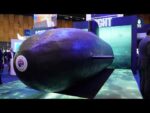Boeing has introduced the CxR (Concept eXperimental Rotorcraft), a new unmanned tiltrotor aircraft designed to operate alongside the AH-64 Apache attack helicopter and CH-47 Chinook heavy-lift helicopter. The system reflects Boeing’s push into next-generation vertical lift capabilities and manned-unmanned teaming (MUM-T) concepts as part of broader U.S. Army modernization efforts.
CxR Concept: A Modular Tiltrotor for Multi-Mission Support
The Boeing CxR is an unmanned vertical takeoff and landing (VTOL) tiltrotor platform designed to perform a range of missions including intelligence, surveillance and reconnaissance (ISR), strike support, resupply/logistics delivery, electronic warfare (EW), and communications relay. The design leverages lessons from previous Boeing rotorcraft programs like the V-22 Osprey and SB>1 Defiant.
The aircraft features a twin-tiltrotor configuration similar in concept to the V-22 but scaled down for unmanned operations. It is optimized for modular payload integration via ventral bays or wing hardpoints. Although Boeing has not disclosed detailed specifications such as range or payload weight at this stage, early renderings suggest it is sized to fit within a CH-47 internal cargo bay or be sling-loaded externally—enhancing operational flexibility.
Designed for MUM-T Operations with Apache and Chinook
A key design driver behind the CxR is enabling seamless manned-unmanned teaming with legacy rotary-wing platforms like the AH-64E Apache Guardian and CH-47F Block II Chinook. These platforms are expected to remain in service into the 2040s under current Army plans.
In a MUM-T scenario, an Apache crew could control one or more CxRs via onboard mission systems to extend their ISR reach beyond line-of-sight or conduct coordinated strikes using loitering munitions carried by the UAV. Similarly, Chinooks could deploy CxRs ahead of troop insertions or resupply missions to scout landing zones or deliver supplies autonomously into contested areas.
This approach aligns with U.S. Army doctrine emphasizing distributed operations in contested environments where autonomous systems reduce risk to human crews while expanding operational tempo.
Part of Future Vertical Lift Ecosystem
The unveiling of CxR comes amid broader U.S. Army efforts under Future Vertical Lift (FVL), which includes several modernization programs such as:
- Future Attack Reconnaissance Aircraft (FARA)
- Future Long Range Assault Aircraft (FLRAA)
- Tactical UAS Modernization
- MUM-T Enablers including Air-Launched Effects (ALE)
While FARA was recently canceled in February 2024 due to shifting priorities toward uncrewed systems and long-range fires, platforms like the CxR may fill some capability gaps left by its termination—particularly in armed reconnaissance roles that require low-risk ISR penetration into denied airspace.
Boeing positions the CxR as complementary rather than competitive with larger FLRAA platforms such as Bell’s V-280 Valor. Its smaller footprint makes it suitable for forward deployment from austere bases or even naval vessels supporting littoral operations.
Technology Enablers: Autonomy, Modular Payloads & Interoperability
Boeing has emphasized that autonomy will be central to the CxR’s architecture. While human-on-the-loop control remains an option via existing helicopter cockpits or ground stations using NATO STANAG-compliant datalinks (e.g., Link-16), full autonomous mission execution—including takeoff/landing and route planning—is envisioned.
The airframe supports plug-and-play modularity through open mission systems architecture compliant with MOSA standards adopted across DoD aviation programs. This allows rapid reconfiguration between ISR pods (EO/IR/SAR), EW payloads (RF jammers/decoys), kinetic strike packages (e.g., small guided munitions), or cargo modules (~50–150 kg class).
Interoperability is another key feature—CxR is being developed with NATO coalition operations in mind. It will likely support secure comms protocols compatible with Joint All-Domain Command & Control (JADC2) frameworks under development by U.S. services.
Status & Next Steps: From Concept Reveal to Prototyping?
Boeing has not confirmed whether a flying prototype exists yet; however, company officials have indicated that ground-based subsystem testing is underway as of late Q3/Q4 FY2025. A demonstrator flight could occur within two years if funding aligns under Army prototyping initiatives such as Project Convergence or AFWERX Autonomy Prime collaborations.
The unveiling appears timed ahead of AUSA Annual Meeting & Exposition in October—a venue often used by OEMs to showcase future concepts before formal program solicitations are issued by Army Futures Command.
If successful, Boeing’s CxR could compete against other industry offerings targeting similar roles—including Northrop Grumman’s Optionally Piloted Vehicle concepts or DARPA’s ANCILLARY VTOL drone initiative focused on shipboard-compatible Group III UAVs.










